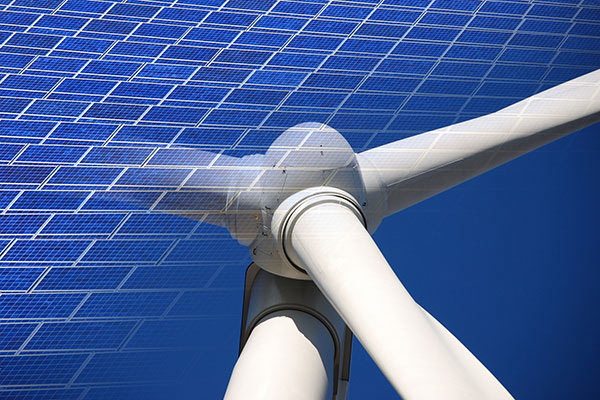Once-hot clean energy is in the doldrums – is it time to buy?
Alternative energy was caught up in the tech boom and bust during the pandemic – but has yet to recover as interest rates peak, writes Sam Benstead.
4th October 2023 12:00
by Sam Benstead from interactive investor

One of the standout investment stories of the pandemic was the rise of clean energy shares. As oil prices plummeted, some companies involved in the transition to net-zero emissions, particularly those trying to provide an alternative power source such as solar or hydrogen, soared in value without increasing their profits proportionally.
The bellwether for the sector was the iShares Global Clean Energy Ucits ETF, which tracks the S&P Global Clean Energy index. From its trough in early 2020, the fund rose 220% by the end of the year. Its journey downwards since then has been just as dramatic, with the exchange-traded fund (ETF) shares dropping £13.98 to £6.50 today. The ETF is one of ii’s ACE 40 sustainable investment ideas.
Big clean energy losers include AIM-quoted ITM Power and Ceres Power, which are down 88% and 79% from their peaks. Both companies are involved in hydrogen power.
Investment trusts in the space are also falling, with the average renewable energy trust down 15.8% this year, according to data from the Association of Investment Companies (AIC).
- Invest with ii: Investing in Bonds | Free Regular Investing | Open a SIPP
This year the iShares Global Clean Energy ETF is off 30%, even as tech-heavy indices have rebounded (the Nasdaq 100 is up 35% in dollar terms this year). The divergence between clean energy and technology shares may worry some investors, who backed clean energy to capitalise on future technology trends.
Meanwhile, fossil fuel companies continue to perform well in share price terms, and also pay strong dividends. So, should investors continue to back clean energy, and what does the future hold for the largest funds in the sector?
The case for clean energy
With global warming more and more evident, leading to extreme weather patterns, governments around the world are prioritising a shift to “net zero” - where an economy has a neutral effect on carbon in the atmosphere through a transition to clean energy and carbon offsetting schemes.
The UK government has pledged to be net zero by 2050, although Rishi Sunak has begun to roll back some targets, such as delaying the ban on buying new fully petrol and diesel cars by 2030.
In the US, President Joe Biden’s Inflation Reduction Act gives subsidies to companies developing green energy.
Fund manager Schroders says the transition to a cleaner and more sustainable energy system represents the “greatest structural shift since the dawn of the internet”. It says that $130 trillion (£107 trillion) of investment into renewable energy is required by 2050 to meet climate targets and therefore the “investment opportunity is huge”.
- Ask ii: Kenyan bonds yield 16% - should I have them in my portfolio?
- China underweight pays off for this Super 60 fund
Mark Lacey, head of global resources at the firm, says that while there was “euphoria” in the sector in 2020, the fall in share prices since then has been healthy and the future is bright for clean energy given the amount of money that needs to be invested in it.
He said: “While you've had this backdrop of an unwind in energy transition equities, from a valuation perspective, the market is really becoming aware that we have this energy crisis.
“And actually, when you look at the demands on the energy system over the next 10, 20 and 30 years, we're going to be short energy unless we put a lot of investment in the ground. Now, that investment in the ground is going to disproportionately go to the energy transition sectors and it's not going to be a straight-line investment.”
Thiemo Lang, manager of the Polar Capital Smart Energy fund, says that the US Inflation Reduction Act is “huge” for clean energy investing.
He said: “This is probably the most comprehensive climate change bill that has ever been launched. We estimate that a total of $370 billion in tax credits are being allocated to it and this will unleash investments of $4 trillion over the next 10 years.”
Lang adds that this will have a significant impact on clean energy supply chains.
“Currently, we are witnessing a significant amount of company announcements saying that [they] are going to move production into the US,” said Lang.
- Should you copy Britain’s best fund managers, or buy their funds?
- Are emerging market fund managers losing patience with China?
The European Union has also announced its own green investment plan, the Green Deal Industrial Plan. Lang says there is now a subsidy race between the US and the EU, which will spur investment.
His portfolio is a big investor in semiconductor stocks, which are the computer chips needed to power electronics, from electric cars to wind turbines. He owns ON Semiconductor Corp (NASDAQ:ON) and Lattice Semiconductor Corp (NASDAQ:LSCC) in his top 10 shares.
Lang does not invest in nuclear energy as he says that there could be a government-driven future, but also points out that there are a lack of investment opportunities for fund managers today.
“Risks include sustainability issues, such as waste disposal and risk of accidents. Nuclear power stations could increase by 20% to 2050, but global electricity demand will increase 250% - so share of energy from nuclear will fall,” he says.
Another winning sector could be utility companies, which distribute energy generated from wind and solar power.
iShares Global Clean Energy Ucits ETF has just over 50% of the portfolio invested in the sector, with a quarter in technology companies and 20% in industrial companies. Interactive investor's head of funds research Dzmitry Lipski says this tracker fund is one of the best ways to get clean energy shares into a portfolio.
Due to the utilities' exposure in this ETF, the price-to-earnings ratio is just 14 times. It owns key energy transition stocks, such as Orsted and Vestas Wind Systems A/S (XETRA:VWSB), which are key to wind power, as well utilities such as Iberdrola in Spain and EDP Energias in Portugal.
- Mining and energy shares: can high dividends be sustained?
- Investor optimism holds as demand for commodities returns
Lipski says that this ETF’s run up in value, before falling back to earth, was linked to the policies supporting clean energy coming out of the US and UK.
He said: “Following the US presidential election and subsequent change in UK climate change policy, clean energy stocks attracted significant inflows and their performance and valuations were pushed to extreme levels.”
To decrease risk that the portfolio became too concentrated, the tracker fund increased its portfolio from 30 to around 100 shares today.
Lipksi said: “We view the recent changes to the index as positive as they add diversification and improve the liquidity profile of the index portfolio. However, we note that the index now includes companies which are not pure-play clean energy stocks, meaning there is a potential for exposure to be diluted.
“We reviewed other clean energy ETFs and concluded that iShares Global Clean Energy ETF remains the best option due to its broad, diversified exposure to the clean energy theme, improved underlying liquidity and its proven track record.”

What caused clean energy share prices to fall?
Part of the reason for the share price bust in many clean energy companies recently is that higher interest rates are putting pressure on companies whose profits are expected in the distant future – which is the case for many richly valued clean tech firms. When rates rise, the risk-free “discount” rate that is plugged into valuation models rises, which causes company valuations to change.
Clean energy shares are also often income investments, meaning that rising bond yields are attracting capital away from the space. Clean energy can also be very capital intensive, so borrowing to fund new investments is increasing costs for companies. This includes investment trusts that use renewable power to generate an income for investors, such as Greencoat UK Wind and JLEN Environmental Assets.
Therefore, despite the big tailwinds for the sector, the short-term outlook is likely to be closely linked to interest rates, unless there is a major breakthrough in clean energy technology (as the broader tech sector got this year with advancements in artificial intelligence).
What about oil and mining shares?
One way to profit from a clean energy boom is to consider fossil fuel and mining shares. Lacey says that oil and gas companies are likely to play a major role in the transition.
“Gas is going to be one of the most important fuels for balancing the grid while we go through this transition. And there's a huge amount of value in those players right now that hold these key assets. So for us, a diversified approach has paid dividends,” the fund manager said.
Lacey says that the transition to clean energy will also cause a spike in demand for key resources, such as lithium and copper, which are used in batteries.
“The other risk is obviously as we go through the energy transition space, you're going to have mineral intensity going up, and the mineral intensity will come from, obviously, lithium availability at first, and then obviously other metals, such as potentially copper.”
“I think you're going to continue to see these mini cycles as we go through the next 10, 15, 20 years of basically roll-out of the energy transition technologies and increasing investment rates.”
Nitesh Shah, head of commodities and macroeconomic research at fund manager Wisdom Tree, predicts a tit-for-tat trade war around the resources required for energy transitions
“We have already seen China put export controls on some of the rare earths to the US and Europe. The long-term game is likely to play out with the prices of these commodities increasing.”
He says that investors can buy the underlying commodities, such as via an ETF, to profit from the price rises. WisdomTree Enhanced Commodity Ucits ETF is one of ii’s Super 60 investment ideas.
A commodities “supercycle” is possible, as Shah says that lots of companies are seeking a net-zero strategy at the same time, so prices should keep rising for energy transition commodities.
Shah was speaking as part of our recent Lunchtime Live discussion entitled “Is there still a place for commodities in your portfolio?”, and hosted by Merryn Somerset Webb.
These articles are provided for information purposes only. Occasionally, an opinion about whether to buy or sell a specific investment may be provided by third parties. The content is not intended to be a personal recommendation to buy or sell any financial instrument or product, or to adopt any investment strategy as it is not provided based on an assessment of your investing knowledge and experience, your financial situation or your investment objectives. The value of your investments, and the income derived from them, may go down as well as up. You may not get back all the money that you invest. The investments referred to in this article may not be suitable for all investors, and if in doubt, an investor should seek advice from a qualified investment adviser.
Full performance can be found on the company or index summary page on the interactive investor website. Simply click on the company's or index name highlighted in the article.